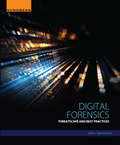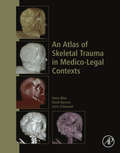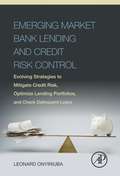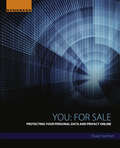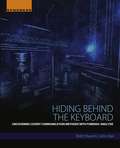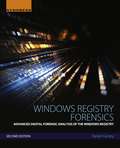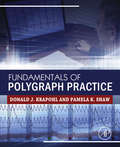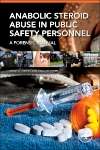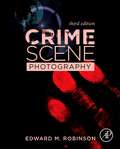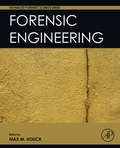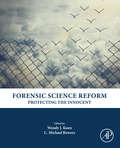- Table View
- List View
Contemporary Digital Forensic Investigations of Cloud and Mobile Applications
by Ali Dehghantanha Kim-Kwang Raymond ChooContemporary Digital Forensic Investigations of Cloud and Mobile Applications comprehensively discusses the implications of cloud (storage) services and mobile applications on digital forensic investigations. The book provides both digital forensic practitioners and researchers with an up-to-date and advanced knowledge of collecting and preserving electronic evidence from different types of cloud services, such as digital remnants of cloud applications accessed through mobile devices. This is the first book that covers the investigation of a wide range of cloud services. Dr. Kim-Kwang Raymond Choo and Dr. Ali Dehghantanha are leading researchers in cloud and mobile security and forensics, having organized research, led research, and been published widely in the field. Users will gain a deep overview of seminal research in the field while also identifying prospective future research topics and open challenges.Presents the most current, leading edge research on cloud and mobile application forensics, featuring a panel of top experts in the fieldIntroduces the first book to provide an in-depth overview of the issues surrounding digital forensic investigations in cloud and associated mobile appsCovers key technical topics and provides readers with a complete understanding of the most current research findingsIncludes discussions on future research directions and challenges
Forensic Odontology: Principles and Practice
by Jim Lewis Thomas J. DavidForensic Odontology: Principles and Practice details the aspects necessary to become an accomplished forensic odontologist, including an illustration of the skills necessary to become an expert witness. The book is ideal for both the experienced and novice forensic odontologist, covering many fields of expertise, including civil and criminal matters. The civil side involves standard of care and personal injury matters, while the criminal side involves not only dental identification, but management of mass fatality incidents, age assessment, child and elder abuse, and bitemark analysis. Provides a comprehensive review of forensic odontology, including the skills necessary to become a competent expert witness Covers the fields of forensic odontology, the basic skills, legal aspects, legal precedents, report writing and expert witness testimonyIncludes numerous illustrations, including charts and graphs, along with B&W and color images
Human Remains: The Application of Imaging to the Study of Human Remains
by Tim Thompson David ErricksonHuman Remains – Another Dimension: The Application of 3D Imaging in the Funerary Contextbrings together scattered literature on the topic, assimilating disparate pieces that relate to the novel use of non-invasive three-dimensional imaging techniques in the forensic context. All chapters are written by specialists in the field who use these types of imaging techniques within their research, bringing an engaging and comprehensive view that demonstrates the current use of 3D non-invasive imaging techniques using case studies. In addition, the advantages for using such methods, their current limitations, and possible solutions are also reviewed. Includes three dimensional imaging techniques presented from a forensics point-of-viewWritten by well-renowned specialists in the fieldAssimilates disparate pieces that relate to the novel use of non-invasive three-dimensional imaging techniques
The Manager's Handbook for Corporate Security: Establishing and Managing a Successful Assets Protection Program
by Gerald L. Kovacich Edward HalibozekThe Manager’s Handbook for Corporate Security: Establishing and Managing a Successful Assets Protection Program, Second Edition, guides readers through today’s dynamic security industry, covering the multifaceted functions of corporate security and providing managers with advice on how to grow not only their own careers, but also the careers of those they manage on a daily basis. This accessible, updated edition provides an implementation plan for establishing a corporate security program, especially for those who have little or no knowledge on the topic. It also includes information for intermediate and advanced professionals who are interested in learning more about general security, information systems security, and information warfare.Addresses today’s complex security industry, the role of the security manager, the diverse set of corporate security functions, and skills for succeeding in this dynamic professionOutlines accessible, comprehensive implementation plans for establishing asset protection programs Provides tactics for intermediate and advanced professionals on the topics of general security, information systems security, and information warfareOffers new perspectives on the future of security and evolving expectations of security professionals
Digital Forensics: Threatscape and Best Practices
by John SammonsDigital Forensics: Threatscape and Best Practices surveys the problems and challenges confronting digital forensic professionals today, including massive data sets and everchanging technology. This book provides a coherent overview of the threatscape in a broad range of topics, providing practitioners and students alike with a comprehensive, coherent overview of the threat landscape and what can be done to manage and prepare for it. Digital Forensics: Threatscape and Best Practices delivers you with incisive analysis and best practices from a panel of expert authors, led by John Sammons, bestselling author of The Basics of Digital Forensics. Learn the basics of cryptocurrencies (like Bitcoin) and the artifacts they generateLearn why examination planning matters and how to do it effectivelyDiscover how to incorporate behaviorial analysis into your digital forensics examinationsStay updated with the key artifacts created by the latest Mac OS, OS X 10.11, El CapitanDiscusses the threatscapes and challenges facing mobile device forensics, law enforcement, and legal casesThe power of applying the electronic discovery workflows to digital forensicsDiscover the value of and impact of social media forensics
Implementing Digital Forensic Readiness: From Reactive to Proactive Process
by Jason SachowskiImplementing Digital Forensic Readiness: From Reactive to Proactive Process shows information security and digital forensic professionals how to increase operational efficiencies by implementing a pro-active approach to digital forensics throughout their organization. It demonstrates how digital forensics aligns strategically within an organization’s business operations and information security’s program. This book illustrates how the proper collection, preservation, and presentation of digital evidence is essential for reducing potential business impact as a result of digital crimes, disputes, and incidents. It also explains how every stage in the digital evidence lifecycle impacts the integrity of data, and how to properly manage digital evidence throughout the entire investigation. Using a digital forensic readiness approach and preparedness as a business goal, the administrative, technical, and physical elements included throughout this book will enhance the relevance and credibility of digital evidence. Learn how to document the available systems and logs as potential digital evidence sources, how gap analysis can be used where digital evidence is not sufficient, and the importance of monitoring data sources in a timely manner. This book offers standard operating procedures to document how an evidence-based presentation should be made, featuring legal resources for reviewing digital evidence.Explores the training needed to ensure competent performance of the handling, collecting, and preservation of digital evidenceDiscusses the importance of how long term data storage must take into consideration confidentiality, integrity, and availability of digital evidenceEmphasizes how incidents identified through proactive monitoring can be reviewed in terms of business riskIncludes learning aids such as chapter introductions, objectives, summaries, and definitions
Identifying Ignitable Liquids in Fire Debris: A Guideline for Forensic Experts
by Jeanet Hendrikse Michiel Grutters Frank SchäferIdentifying Ignitable Liquids in Fire Debris: A Guideline for Forensic Experts discusses and illustrates the characteristics of different ignitable liquid products. This guideline builds on the minimum criteria of the ignitable liquid classes defined in the internationally accepted standard ASTM E1618 Standard Test Method for Ignitable Liquid Residues in Extracts from Fire Debris Samples by Gas Chromatography-Mass Spectrometry. The volume provides information on the origin of the characteristics of these ignitable liquid products and provides a summary of characteristics to demonstrate a positive identification of the particular product class. Topics such as the term ignitable liquid, relevant guidelines for fire debris analysis, production processes of ignitable liquids, fire debris analysis methods, and interferences in fire debris analysis, are briefly discussed as these topics are essential for the understanding of the identification and classification of ignitable liquid residues in fire debris.Discusses the characteristics and variations in chemical composition of different classes of the ignitable liquid products defined by ASTM E1618:14Covers the General Production Processes of Ignitable Liquid ProductsIncludes a guide for the Identification of Ignitable Liquids in Fire Debris
The Law of Emergencies: Public Health and Disaster Management
by Nan D. HunterThe Law of Emergencies: Public Health and Disaster Management, Second Edition, introduces the American legal system as it interacts with disaster management, public health and civil unrest issues. Nan Hunter shows how the law in this area plays out in the context of real life emergencies where individuals often have to make split-second decisions. This book covers the major legal principles underlying emergency policy and operations and analyzes legal authority at the federal, state and local levels, placing the issues in historical context but concentrating on contemporary questions. The book includes primary texts, reader-friendly expository explanation and sample discussion questions in each chapter, as well as scenarios for each of the three major areas to put the concepts in to action. Prior knowledge of the law is not necessary in order to use and understand this book, and it satisfies the need of professionals in a wide array of fields related to emergency management to understand both what the law requires and how to analyze issues for which there is no clear legal answer. The book features materials on such critical issues as how to judge the extent of Constitutional authority for government to intervene in the lives and property of American citizens. At the same time, it also captures bread-and-butter issues such as responder liability and disaster relief methods. No other book brings these components together in a logically organized, step by step fashion.Updated with expanded coverage and several new chaptersRe-organized to improve topic focus, with sections covering The President, Congress, and the Courts; Governance on the Ground; The Rights of Individuals; Disaster Management and Reconstruction; Health Emergencies; Preserving the Social Fabric; and LiabilityIncludes a new disaster scenario (a dirty bomb explosion in Washington, DC) to illustrate the application of key conceptsFeatures two new appendices that provide key excerpts from the U.S. Constitution and the Stafford Act Includes a new glossary of legal and legislative terms
An Atlas of Skeletal Trauma in Medico-Legal Contexts
by Soren Blau David Ranson Chris O'DonnellPost-mortem computed tomography (PMCT) is increasingly used in forensic pathology practice in many jurisdictions. Such imaging has expanded the capacity to evaluate skeletal trauma improving the visualisation, documentation and presentation of forensic findings. Typically when deceased persons are located and exhibit evidence of trauma, forensic pathologist, anthropologists and radiologists base their interpretations of the mechanism of trauma on their experience and understanding of the biomechanics of fractures as well as recognisable patterns of injury. In order to augment this process, An Atlas of Forensic Skeletal Trauma presents a range of de-identified adult and child skeletal trauma cases that occur in medico-legal contexts where the cause of death and mechanism of trauma are recorded. An Atlas of Forensic Skeletal Trauma includes comprehensive photographs and PMCT images as well as descriptive text.Presents a valuable guide to the interpretation of skeletal trauma for practitioners and students of forensic anthropology, pathology and radiologyProvides coverage of skeletal trauma cases resulting from high and low velocity projectiles, low energy blunt force (e.g., assaults involving various implements, hangings, strangulations, falls), high energy blunt force (e.g., motor vehicle and aviation incidents), and moreIncludes case studies with written and visual descriptions, discussions and up-to-date literature review
Human Body Decomposition
by Marc Oxenham Jarvis HaymanThe fate of the human body after death is a subject that has fascinated enquirers, both in the scientific and legal realms for millennia. However, objective research into the causes and nature of human decomposition has only taken place in the last two centuries, and quantitative measurement of the process as a means of estimating the time of death has only recently been attempted. The substantial literature concerning this research has been published in numerous scientific journals since the beginning of the nineteenth century. Human Body Decomposition expands on the current literature to include the evolving research on estimating the time of death. This volume details the process of decomposition to include early period after death when the body cools to ambient temperature, and when the body begins to putrefy. This process is significant because the estimation of the time of death becomes increasingly more difficult when the body begins to putrefy.Human Body Decomposition compiles a chronological account of research into the estimation of the time since death in human bodies found decomposed in order that researchers in the subject field can concentrate their thoughts and build on what has been achieved in the past.Provides concise details of research, over the last 200 years, of estimating the time of death in decomposed bodies.Covers methods of research into human decomposition in the stages of body cooling to ambient temperature and the later stages of autolysis, putrefaction and skeletonisation.Includes a detailed account of recent research and future concepts. Concludes with an account of the difficulties which future research into human decomposition will encounter.
Essentials of Medicolegal Death Investigation
by Matthew M. LunnEssentials of Medicolegal Death Investigation uses a unique approach by combining medical issues, injury patterns, and investigative procedures to provide the reader with the basic fundamentals for a death investigation. The text introduces the reader to death investigation, common causes of death, and very specific types of death, including blunt-force injuries, gunshot wounds, and toxicology deaths. Each section includes case studies with written and visual descriptions. Written by a well-known and experienced medicolegal death investigator, the book fills a void in medicolegal literature for both students and professionals alike.Provides a valuable guide to the interpretation of medical death investigation for practitioners and studentsCovers the following circumstances in death investigations: asphyxiation, blunt-force injuries, sharp-force injuries, gunshot wounds, toxicology deaths, and natural causesIncludes case studies with written and visual descriptions and discussion, as well as up-to-date literature review
Latent Print Processing Guide
by Stephen P. KasperLatent prints are chance or accidental impressions left by friction-ridge skin on a surface, regardless of whether they are visible or invisible at the time of deposition. Recognition of evidence that may contain fingerprints and the processes that can develop these latent prints is crucial in preventing valuable evidence from being left undetected. Latent Print Processing Guide goes beyond the basic police training, covering latent prints in detail and providing first responders with adequate training and guidelines. To process latent prints, examiners use various techniques including electronic, chemical, cyanoacrylate, and physical methods. Latent Print Processing Guide offers a broad understanding of latent print detection, development, and recovery, including insights on stateof-the-art technologies.Includes history of latent print identification and some of the pioneers and their contributions. Defines the differences between chemical and physical processes and explains process sequence protocols and recovery methods for different types of evidence.Chapters include: process selection, application and recovery, special considerations for specific materials, protocol sequence and process formulas, including required materials, application method, expected results, safety measures, and references.The text is written so that non-crime scene or non-crime laboratory personnel can also gain valuable information from it.
Forensic Psychology of Spousal Violence
by Mauro PaulinoExploring the dynamics between victim and offender is paramount to answering important issues of character and vital for forensic research. This involves examining the role of the victim during and after victimization; this process is especially important for spousal violence because of the interactive process between the victim and the offender.Forensic Psychology of Spousal Violence covers the phenomenon of spousal violence and its different forms, discussing the consequences of abuse, providing research tips to be used in the field, including relevant case studies and much more. The innovative approach of this text fills a void in the current understanding of spousal violence.Uses international statistics to present data of women battered and/or deceased to educate, change mindsets and practices and ultimately reduce the number of battered women and spousal homicides in the futureIncludes current case studiesIncludes best practices for spousal abuse investigationsPortable for use in fieldwork
Digital Forensics Trial Graphics: Teaching the Jury through Effective Use of Visuals
by John Sammons Lars DanielDigital Forensics Trial Graphics: Teaching the Jury Through Effective Use of Visuals helps digital forensic practitioners explain complex technical material to laypeople (i.e., juries, judges, etc.). The book includes professional quality illustrations of technology that help anyone understand the complex concepts behind the science. Users will find invaluable information on theory and best practices along with guidance on how to design and deliver successful explanations.Helps users learn skills for the effective presentation of digital forensic evidence via graphics in a trial setting to laypeople such as juries and judgesPresents the principles of visual learning and graphic design as a foundation for developing effective visualsDemonstrates the best practices of slide design to develop effective visuals for presentation of evidenceProfessionally developed graphics, designed specifically for digital forensics, that you can use at trialDownloadable graphics available at: http://booksite.elsevier.com/9780128034835
Data Breach Preparation and Response: Breaches are Certain, Impact is Not
by Kevvie FowlerData Breach Preparation and Response: Breaches are Certain, Impact is Not is the first book to provide 360 degree visibility and guidance on how to proactively prepare for and manage a data breach and limit impact. Data breaches are inevitable incidents that can disrupt business operations and carry severe reputational and financial impact, making them one of the largest risks facing organizations today. The effects of a breach can be felt across multiple departments within an organization, who will each play a role in effectively managing the breach. Kevvie Fowler has assembled a team of leading forensics, security, privacy, legal, public relations and cyber insurance experts to create the definitive breach management reference for the whole organization. Discusses the cyber criminals behind data breaches and the underground dark web forums they use to trade and sell stolen dataFeatures never-before published techniques to qualify and discount a suspected breach or to verify and precisely scope a confirmed breachHelps identify your sensitive data, and the commonly overlooked data sets that, if stolen, can result in a material breach Defines breach response plan requirements and describes how to develop a plan tailored for effectiveness within your organizationExplains strategies for proactively self-detecting a breach and simplifying a responseCovers critical first-responder steps and breach management practices, including containing a breach and getting the scope right, the first timeShows how to leverage threat intelligence to improve breach response and management effectivenessOffers guidance on how to manage internal and external breach communications, restore trust, and resume business operations after a breach, including the critical steps after the breach to reduce breach-related litigation and regulatory finesIllustrates how to define your cyber-defensible position to improve data protection and demonstrate proper due diligence practices
Emerging Market Bank Lending and Credit Risk Control: Evolving Strategies to Mitigate Credit Risk, Optimize Lending Portfolios, and Check Delinquent Loans
by Leonard OnyiriubaUsing a framework of volatile markets Emerging Market Bank Lending and Credit Risk Control covers the theoretical and practical foundations of contemporary credit risk with implications for bank management. Drawing a direct connection between risk and its effects on credit analysis and decisions, the book discusses how credit risk should be correctly anticipated and its impact mitigated within framework of sound credit culture and process in line with the Basel Accords. This is the only practical book that specifically guides bankers through the analysis and management of the peculiar credit risks of counterparties in emerging economies. Each chapter features a one-page overview that introduces its subject and its outcomes. Chapters include summaries, review questions, references, and endnotes.Emphasizes bank credit risk issues peculiar to emerging economiesExplains how to attain asset and portfolio quality through efficient lending and credit risk management in high risk-prone emerging economiesPresents a simple structure, devoid of complex models, for creating, assessing and managing credit and portfolio risks in emerging economiesProvides credit risk impact mitigation strategies in line with the Basel Accords
You: Protecting Your Personal Data and Privacy Online
by Stuart SumnerEverything we do online, and increasingly in the real world, is tracked, logged, analyzed, and often packaged and sold on to the highest bidder. Every time you visit a website, use a credit card, drive on the freeway, or go past a CCTV camera, you are logged and tracked. Every day billions of people choose to share their details on social media, which are then sold to advertisers. The Edward Snowden revelations that governments - including those of the US and UK – have been snooping on their citizens, have rocked the world. But nobody seems to realize that this has already been happening for years, with firms such as Google capturing everything you type into a browser and selling it to the highest bidder. Apps take information about where you go, and your contact book details, harvest them and sell them on – and people just click the EULA without caring. No one is revealing the dirty secret that is the tech firms harvesting customers’ personal data and selling it for vast profits – and people are totally unaware of the dangers. You: For Sale is for anyone who is concerned about what corporate and government invasion of privacy means now and down the road. The book sets the scene by spelling out exactly what most users of the Internet and smart phones are exposing themselves to via commonly used sites and apps such as facebook and Google, and then tells you what you can do to protect yourself. The book also covers legal and government issues as well as future trends. With interviews of leading security experts, black market data traders, law enforcement and privacy groups, You: For Sale will help you view your personal data in a new light, and understand both its value, and its danger.Provides a clear picture of how companies and governments harvest and use personal data every time someone logs onDescribes exactly what these firms do with the data once they have it – and what you can do to stop itLearn about the dangers of unwittingly releasing private data to tech firms, including interviews with top security experts, black market data traders, law enforcement and privacy groupsUnderstand the legal information and future trends that make this one of the most important issues today
Hiding Behind the Keyboard: Uncovering Covert Communication Methods with Forensic Analysis
by Brett Shavers John BairHiding Behind the Keyboard: Uncovering Covert Communication Methods with Forensic Analysis exposes the latest electronic covert communication techniques used by cybercriminals, along with the needed investigative methods for identifying them. The book shows how to use the Internet for legitimate covert communication, while giving investigators the information they need for detecting cybercriminals who attempt to hide their true identity. Intended for practitioners and investigators, the book offers concrete examples on how to communicate securely, serving as an ideal reference for those who truly need protection, as well as those who investigate cybercriminals.Covers high-level strategies, what they can achieve, and how to implement themShows discovery and mitigation methods using examples, court cases, and moreExplores how social media sites and gaming technologies can be used for illicit communications activitiesExplores the currently in-use technologies such as TAILS and TOR that help with keeping anonymous online
Windows Registry Forensics: Advanced Digital Forensic Analysis of the Windows Registry
by Harlan CarveyWindows Registry Forensics: Advanced Digital Forensic Analysis of the Windows Registry, Second Edition, provides the most in-depth guide to forensic investigations involving Windows Registry. This book is one-of-a-kind, giving the background of the Registry to help users develop an understanding of the structure of registry hive files, as well as information stored within keys and values that can have a significant impact on forensic investigations. Tools and techniques for post mortem analysis are discussed at length to take users beyond the current use of viewers and into real analysis of data contained in the Registry. This second edition continues a ground-up approach to understanding so that the treasure trove of the Registry can be mined on a regular and continuing basis.Named a Best Digital Forensics Book by InfoSec ReviewsPacked with real-world examples using freely available open source toolsProvides a deep explanation and understanding of the Windows Registry—perhaps the least understood and employed source of information within Windows systemsIncludes a companion website that contains the code and author-created tools discussed in the bookFeatures updated, current tools and techniquesContains completely updated content throughout, with all new coverage of the latest versions of Windows
Fundamentals of Polygraph Practice
by Donald Krapohl Pamela ShawThough polygraph has been the mainstay for government and police departments since World War II, it has undergone substantial transformation in recent years. Fundamentals of Polygraph Practice bridges the gap between the outmoded practices and today’s validated testing and analysis protocols. The goal of this reference is to thoroughly and concisely describe the evidence-based practices of polygraphy. Coverage will include: psychophysiology, testing techniques, data collection, data analysis, ethics, polygraph law, alternate technologies and much more. This text addresses the foundational needs of polygraph students, and is written to be useful and accessible to attorneys, forensic scientists, consumers of polygraph services, and the general public.Includes protocols and fundamentals of polygraph practiceCovers the history of lie detection, psychophysiology, data collection, techniques and testing, data analysis and much moreAuthors are internationally recognized in the polygraph field
Forensic Psychiatry: A Lawyer’s Guide
by Vivian ShnaidmanLawyers frequently encounter clients and/or cases of bizarre behavior, mental illness, substance abuse, psychopathy, sexual offenses, learning disorders, birth defects, and other behavioral and emotional issues. Often they are ill-prepared to understand the nature of the psychiatric report, how the psychiatric assessment was structured, and how to best utilize and challenge these reports in court.Forensic Psychiatry: A Lawyer’s Guide provides legal professionals the tools to identify mentally ill clients and help them navigate through the psychiatric information and language in reports and testimony. Topics include why a forensic psychiatrist is necessary, applications of psychiatry to law, various psychiatric disorders, and utilizing the expert witness.A user-friendly roadmap to psychiatry for the non-psychiatrist—covers why you need a forensic psychiatrist and the applications of psychiatry to lawProvides coverage of the mental status examination, common psychiatric diagnoses, treatable disorders versus brain damage, medical problems masquerading as mental illness, and much moreIncludes a full glossary of psychiatric terms as an additional easy reference guide
Anabolic Steroid Abuse in Public Safety Personnel: A Forensic Manual
by Brent E. Turvey Stan CrowderAnabolic Steroid Abuse in Public Safety Personnel: A Forensic Manual provides readers with information on both the history and overwhelming evidence relating to steroid abuse in the law enforcement subculture. The text raises awareness regarding the pervasiveness of the problem that has grown into a systemic and nationwide phenomenon, and then addresses the consequences of anabolic steroid abuse on individual health, agency liability, and public safety. Particular attention is paid to forensic issues, including investigative, evidentiary, and legal concerns, facilitating just and lawful outcomes when these crimes are suspected or exposed.Provides readers with information on both the history and overwhelming evidence relating to steroid abuse in the law enforcement subcultureAn investigative and forensic desk reference manual for investigators and attorneys Pays particular attention to forensic issues, including investigative, evidentiary, and legal concerns
Crime Scene Photography
by Edward M. RobinsonCrime Scene Photography, Third Edition, covers the general principles and concepts of photography, while also delving into the more practical elements and advanced concepts of forensic photography. Robinson assists the reader in understanding and applying essential concepts in order to create images that are able to withstand challenges in court. This text is a required reading by both the International Association for Identification’s Crime Scene Certification Board and the Forensic Photography Certification Board. Includes an instructor website with lecture slides, practical exercises, a test bank, and image collection and many videos which can be used.Extensively illustrated with over 1000 full color photographs, with many images entirely new for the third editionOver 100 practical exercises help the reader grasp the practical applicationsVariations of correct and incorrect approaches, to be used alongside practical exercises, available online in the Instructor’s ManualThe chapter on Special Photographic Situations includes new sections on autopsy photography, images from drones, recommendations to photographically document bloodstain patterns and firearms trajectories
Forensic Engineering
by Max M. HouckForensic Engineering, the latest edition in the Advanced Forensic Science series that grew out of recommendations from the 2009 NAS Report: Strengthening Forensic Science: A Path Forward, serves as a graduate level text for those studying and teaching digital forensic engineering, as well as an excellent reference for a forensic scientist’s library or for their use in casework. Coverage includes investigations, transportation investigations, fire investigations, other methods and professional issues. Edited by a world-renowned leading forensic expert, this series is a long overdue solution for the forensic science community. Provides basic principles of forensic science and an overview of forensic engineeringContains sections on investigations, transportation investigations, fire investigations and other methodsIncludes a section on professional issues, such as: from crime scene to court, forensic laboratory reports and health and safetyIncorporates effective pedagogy, key terms, review questions, discussion questions and additional reading suggestions
Forensic Science Reform: Protecting the Innocent
by Wendy J. Koen C. Michael BowersForensic Science Reform: Protecting the Innocent is written for the nonscientist to help make complicated scientific information clear and concise enough for attorneys and judges to master. This volume covers physical forensic science, namely arson, shaken baby syndrome, non-accidental trauma, bite marks, DNA, ballistics, comparative bullet lead analysis, fingerprint analysis, and hair and fiber analysis, and contains valuable contributions from leading experts in the field of forensic science.Offers training for prosecuting attorneys on the present state of the forensic sciences in order to avoid reliance on legal precedent that lags decades behind the scienceProvides defense attorneys the knowledge to defend their clients against flawed scienceArms innocence projects and appellate attorneys with the latest information to challenge convictions that were obtained using faulty scienceUses science-specific case studies to simplify issues in forensic science for the legal professionalOffers a detailed overview of both the failures and progress made in the forensic sciences, making the volume ideal for law school courses covering wrongful convictions, or for undergraduate courses on law, legal ethics, or forensics




